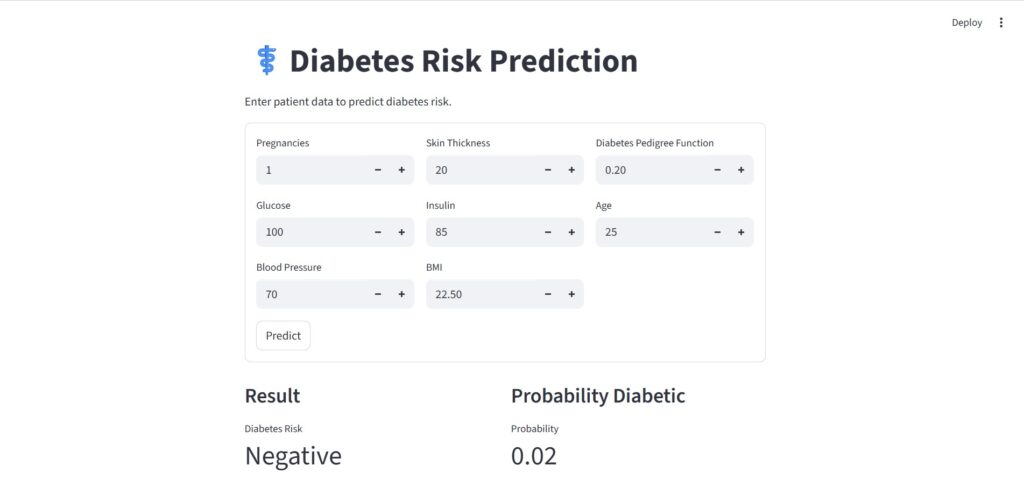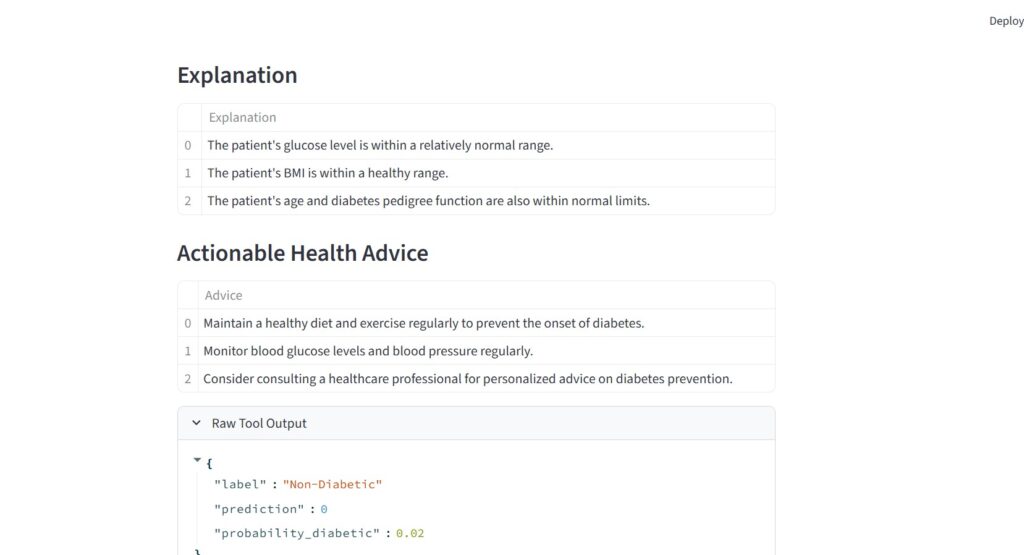Machine Learning Powered by Agentic AI is evolving from simply making predictions to acting intelligently based on them. While Machine Learning (ML) models have long been capable of analyzing data and producing results, they traditionally stop short of taking further action. Enter Agentic AI — the next frontier that combines the analytical power of ML with the autonomy and reasoning of AI agents.
This article explores how Machine Learning can be powered by Agentic AI frameworks like CrewAI, using a practical healthcare example — predicting diabetes risk using a RandomForest model embedded inside an intelligent AI agent.
Table of Contents
What Is Agentic AI?
Before diving into the implementation, let’s understand the foundation.
Agentic AI refers to autonomous AI systems that can reason, decide, and act on goals. Unlike conventional Generative AI (like ChatGPT) which only generates text or insights, Agentic AI can use tools, process data, make decisions, and perform real-world actions.
In essence:
- Generative AI = Thinks and writes
- Agentic AI = Thinks, decides, and acts
Agentic AI frameworks such as CrewAI, LangGraph, and AutoGPT use Large Language Models (LLMs) as the brain, while tools like APIs or ML models act as their hands.
So when you combine a Machine Learning model (for predictive intelligence) with Agentic AI (for reasoning and decision-making), you get a system that’s both smart and actionable.
The Idea: Machine Learning Powered by Agentic AI
Imagine you’ve built a RandomForest machine learning model that predicts whether a patient is diabetic or not.
A typical ML model might take patient data as input, make a prediction, and return a label such as “Positive” or “Negative.”
However, in an Agentic AI system, this ML model is just one tool in a broader intelligent workflow.
The AI agent:
- Collects patient data.
- Uses the ML model to predict the result.
- Interprets that prediction in natural language.
- Provides explanations and health recommendations.
- Optionally stores, reports, or acts upon those findings.
Let’s see how this works in code.
Example Input: Patient Health Data
We start with a patient’s medical information represented as a Python dictionary:
patient_diabetic = {
"Pregnancies": 3,
"Glucose": 150,
"BloodPressure": 80,
"SkinThickness": 25,
"Insulin": 100,
"BMI": 30.5,
"DiabetesPedigreeFunction": 0.6,
"Age": 40
}
This data represents typical health metrics that influence diabetes risk.
A trained RandomForestClassifier model can process this data to make a probabilistic prediction.
The Machine Learning Tool
In your setup, the ML model is wrapped as a CrewAI tool, making it accessible to agents within the framework.
Here’s how you define it:
from crewai_tools import tool
@tool("Diabetes Prediction Tool")
def predict_diabetes(patient_data: dict) -> dict:
# ML model prediction logic
pred_class = model.predict([list(patient_data.values())])[0]
pred_prob = model.predict_proba([list(patient_data.values())])[0][1]
label = "Positive" if pred_class == 1 else "Negative"
return {
"prediction": int(pred_class),
"label": label,
"probability_diabetic": float(pred_prob)
}
This simple yet powerful function bridges traditional ML and Agentic AI.
When the AI agent calls this tool, it gets a structured response with both the predicted class and probability.
Making the Output More Human-Friendly
While the raw output is useful for developers, Agentic AI systems are designed to communicate results naturally.
That’s where your expected_output format comes in.
Here’s an enhanced output format your AI agent could return:
expected_output = {
"diabetes_risk_prediction": {
"result": "Positive",
"probability": 0.87,
"test_result_natural_language": (
"The model predicts a high probability (87%) that the patient may be diabetic."
),
},
"explanation": [
"High glucose level (150 mg/dL) increases diabetes risk.",
"BMI of 30.5 indicates moderate obesity.",
"Family diabetes history (pedigree = 0.6) adds to the likelihood."
],
"actionable_health_advice": [
"Consult a certified endocrinologist for further evaluation.",
"Adopt a low-glycemic diet rich in vegetables and whole grains.",
"Increase physical activity to at least 30 minutes per day.",
"Monitor blood glucose levels regularly."
],
"tool_output": {
"prediction": 1,
"label": "Positive",
"probability_diabetic": 0.87
}
}
Now, instead of just predicting numbers, your Agentic AI system can explain, interpret, and recommend actions, making it immensely more valuable for real-world healthcare applications.
Building the Agent in CrewAI
The next step is defining an agent that uses this ML-powered tool.
from crewai import Agent
healthcare_agent = Agent(
role="Medical AI Assistant",
goal="Predict and explain the risk of diabetes using patient health data.",
backstory="An AI healthcare assistant designed to analyze patient information and provide actionable insights.",
tools=[predict_diabetes],
)
This agent can:
- Accept patient data as input
- Call the ML model tool (
predict_diabetes) - Interpret the model’s output
- Generate natural language explanations and advice
Then, define a task for the agent:
from crewai import Task
diabetes_prediction_task = Task(
description="Analyze patient data and provide diabetes prediction with health advice.",
agent=healthcare_agent
)
Finally, create a Crew to run the process:
from crewai import Crew
medical_crew = Crew(
agents=[healthcare_agent],
tasks=[diabetes_prediction_task],
verbose=True
)
medical_crew.run()


How the Agentic Workflow Operates
- Input Phase:
The CrewAI system passes thepatient_diabeticdictionary to the agent. - Tool Execution:
The agent calls theDiabetes Prediction Tool(your RandomForest ML model) to generate predictions. - Reasoning & Interpretation:
The LLM (like GPT) inside the agent interprets the tool’s numeric output, formats it into human language, and explains the reasoning behind it. - Recommendation Generation:
Based on context, the agent offers actionable healthcare recommendations. - Output Delivery:
The agent returns a structured, understandable, and insightful report to the user or medical platform.
Why Combine Machine Learning with Agentic AI?
This integration creates a powerful synergy that overcomes the traditional limits of both technologies.
| Feature | Machine Learning | Agentic AI | ML + Agentic AI |
|---|---|---|---|
| Core Function | Predict outcomes | Reason & act | Predict, reason & act |
| Output Type | Numeric / categorical | Text & actions | Structured, contextual |
| User Interaction | Developer-centric | User-centric | Both technical & conversational |
| Decision Autonomy | None | High | High + data-driven |
| Example Use | Predict diabetes | Explain health risks | Predict + Explain + Advise |
By combining both, you get interpretable, explainable, and actionable intelligence — essential in fields like healthcare, finance, and insurance, where trust and transparency matter.
Advantages of ML-Powered Agentic AI Systems
1. Enhanced Explainability
Traditional ML models often work like “black boxes.” Agentic AI can explain why a certain decision was made in human-readable form.
2. End-to-End Automation
From data input to decision-making and advice, the entire workflow runs autonomously.
3. Adaptability
Agents can use multiple tools — not just ML models, but also APIs, knowledge bases, and medical guidelines — to improve recommendations.
4. Domain Personalization
You can create multiple specialized agents (e.g., “CardioHealthAgent,” “DietAdvisorAgent”) that work collaboratively within a CrewAI system.
5. Continuous Learning
Agents can retain memory of previous predictions and outcomes to improve over time, creating a feedback-driven intelligence loop.
Real-World Implications in Healthcare
The implications of this setup are huge:
- Hospitals can deploy Agentic AI assistants to assist doctors in initial risk assessments.
- Telemedicine platforms can provide personalized advice before consultations.
- Public health systems can use agents to monitor large datasets for disease pattern detection.
- Patients can receive automated lifestyle guidance based on model outputs.
By combining data-driven ML models with contextual reasoning AI agents, healthcare predictions become more human, transparent, and actionable.
Best Practices When Using ML Tools in CrewAI
- Validate Your Model:
Ensure your RandomForest or ML model is trained and tested with reliable datasets. - Use Standardized Input:
Maintain consistent data schemas (likepatient_diabetic) for tool compatibility. - Add Interpretability Layers:
Use SHAP or LIME alongside CrewAI agents to produce model explanation summaries. - Ensure Ethical AI Use:
Clearly communicate that the AI provides recommendations, not medical diagnoses. - Log and Monitor:
Use CrewAI’s verbose mode to audit agent reasoning, model outputs, and recommendations.
The Future: Agentic AI + ML = Cognitive Systems
The combination of Machine Learning models and Agentic AI agents is the foundation of cognitive systems — AI that not only analyzes but also reasons, communicates, and acts.
Soon, similar architectures will enable:
- Autonomous healthcare monitoring agents
- AI-powered financial advisors
- Smart diagnostic assistants integrated with wearable devices
The fusion of ML and Agentic AI bridges the gap between data intelligence and cognitive action — a true evolution toward intelligent automation.
Conclusion
The collaboration of Machine Learning and Agentic AI represents a major leap forward in AI capabilities. By embedding an ML model (like RandomForest) as a CrewAI tool, you can transform static predictions into dynamic, explainable, and actionable insights.
Your example — using a diabetes prediction model within a CrewAI agent — demonstrates how AI systems can become trusted digital assistants in healthcare, capable of not just predicting disease risk, but also guiding patients toward better health outcomes.
As this paradigm spreads across industries, it will redefine how intelligent systems interact with humans — not merely as tools for data analysis, but as autonomous partners for decision-making and action.
Code is here
Read More on https://techtogeek.com/






This is fantastic! Its like teaching your ML model to be less of a spreadsheet and more of a chatty, helpful doctors assistant. Watching it go from spitting out Positive to giving *actual* advice is brilliant. The idea of an AI explaining its thinking like, Hmm, high glucose and a slightly chubby BMI suggest… consult an endocrinologist! is gold. Its the difference between a robot saying 1 and a robot saying, You should probably lay off the donuts, Bob. Honestly, give me an Agentic AI-powered ML any day – its like having a slightly overeager, explainable intern who never asks for overtime. Just tell it to leave the medical diagnoses to the humans.